Associations Between Sprint Mechanical Properties and Change of Direction Ability and Asymmetries in COD Speed Performance in Basketball and Volleyball Players
Abstract
1. Introduction
2. Materials and Methods
2.1. Participants
2.2. Study Design
2.3. Sprint Force–Velocity Profile Test
2.4. COD Performance Tests
2.4.1. Modified Agility T-Test (MAT)
2.4.2. 505 COD Test
2.5. Data Processing
2.6. Statistical Analyses
3. Results
4. Discussion
5. Conclusions
6. Practical Application
Author Contributions
Funding
Institutional Review Board Statement
Informed Consent Statement
Data Availability Statement
Acknowledgments
Conflicts of Interest
References
- Scanlan, A.T.; Madueno, M.C.; Guy, J.H.; Giamarelos, K.; Spiteri, T.; Dalbo, V.J. Measuring Decrement in Change-of-Direction Speed Across Repeated Sprints in Basketball: Novel vs. Traditional Approaches. J. Strength Cond. Res. 2021, 35, 841–845. [Google Scholar] [CrossRef] [PubMed]
- Gonzalo-Skok, O.; Dos’Santos, T.; Bishop, C. Assessing Limb Dominance and Interlimb Asymmetries Over Multiple Angles During Change of Direction Speed Tests in Basketball Players. J. Strength Cond. Res. 2023, 37, 2423–2430. [Google Scholar] [CrossRef] [PubMed]
- Lockie, R.G.; Dawes, J.J.; Callaghan, S.J. Lower-body power, linear speed, and change-of-direction speed in division I collegiate women’s volleyball players. Biol. Sport 2020, 37, 423–428. [Google Scholar] [CrossRef]
- Scanlan, A.; Dascombe, B.; Reaburn, P. A comparison of the activity demands of elite and sub-elite Australian men’s basketball competition. J. Sports Sci. 2011, 29, 1153–1160. [Google Scholar] [CrossRef]
- Willberg, C.; Kohler, A.; Zentgraf, K. Construct Validity and Applicability of a Team-Sport-Specific Change of Direction Test. J. Hum. Kinet. 2023, 85, 115–126. [Google Scholar] [CrossRef]
- Williams, M.N.C.; Wen, N.; Pyne, D.B.; Ferioli, D.; Conte, D.; Dalbo, V.J.; Scanlan, A.T. Anthropometric and Power-Related Attributes Differ Between Competition Levels in Age-Matched Under-19-Year-Old Male Basketball Players. Int. J. Sports Physiol. Perform. 2022, 17, 562–568. [Google Scholar] [CrossRef]
- Scanlan, A.T.; Wen, N.; Pyne, D.B.; Stojanović, E.; Milanović, Z.; Conte, D.; Vaquera, A.; Dalbo, V.J. Power-Related Determinants of Modified Agility T-test Performance in Male Adolescent Basketball Players. J. Strength Cond. Res. 2021, 35, 2248–2254. [Google Scholar] [CrossRef]
- Martín-López, J.; Sedliak, M.; Valadés, D.; Muñoz, A.; Buffet-García, J.; García-Oviedo, R.; Rodríguez-Aragón, M.; Pérez-López, A.; López-Samanes, Á. Impact of time-of-day and chronotype on neuromuscular performance in semi-professional female volleyball players. Chronobiol. Int. 2022, 39, 1006–1014. [Google Scholar] [CrossRef]
- Sekulic, D.; Spasic, M.; Mirkov, D.; Cavar, M.; Sattler, T. Gender-Specific Influences of Balance, Speed, and Power on Agility Performance. J. Strength Cond. Res. 2013, 27, 802–811. [Google Scholar] [CrossRef]
- Wen, N.; Dalbo, V.J.; Burgos, B.; Pyne, D.B.; Scanlan, A.T. Power Testing in Basketball: Current Practice and Future Recommendations. J. Strength Cond. Res. 2018, 32, 2677–2691. [Google Scholar] [CrossRef]
- Pleša, J.; Kozinc, Ž.; Šarabon, N. Bilateral Deficit in Countermovement Jump and Its Influence on Linear Sprinting, Jumping, and Change of Direction Ability in Volleyball Players. Front. Physiol. 2022, 13, 768906. [Google Scholar] [CrossRef] [PubMed]
- Nimphius, S.; Spiteri, T.; Geib, G.; Carlisle, D. “Change of direction deficit” measurement in Division I American football players. J. Aust. Strength Cond. 2013, 21, 115–117. [Google Scholar]
- Amoako-Sakyi, D.; Obiri-Yeboah, D.; Ofosu, A.; Kusi, K.A.; Osei, K.; Adade, R.; Aniakwaa-Bonsu, E.; Quansah, R.; Arko-Mensah, J.; Amoah, B.Y.; et al. Preponderance of vaccine-preventable diseases hotspots in northern Ghana: A spatial and space-time clustering analysis from 2010 to 2014. BMC Public Health 2022, 22, 1899. [Google Scholar] [CrossRef]
- Henríquez, M.; Peña-González, I.; Albaladejo-García, C.; Sadarangani, K.P.; Reina, R. Sex differences in change of direction deficit and asymmetries in footballers with cerebral palsy. Scand. J. Med. Sci. Sports 2023, 33, 1519–1530. [Google Scholar] [CrossRef]
- DosʼSantos, T.; Thomas, C.; Jones, P.A.; Comfort, P. Assessing Asymmetries in Change of Direction Speed Performance: Application of Change of Direction Deficit. J. Strength Cond. Res. 2019, 33, 2953–2961. [Google Scholar] [CrossRef]
- Nimphius, S.; Callaghan, S.J.; Spiteri, T.; Lockie, R.G. Change of Direction Deficit: A More Isolated Measure of Change of Direction Performance Than Total 505 Time. J. Strength Cond. Res. 2016, 30, 3024–3032. [Google Scholar] [CrossRef]
- Bishop, C.; Weldon, A.; Hughes, J.; Brazier, J.; Loturco, I.; Turner, A.; Read, P. Seasonal Variation of Physical Performance and Inter-limb Asymmetry in Professional Cricket Athletes. J. Strength Cond. Res. 2021, 35, 941–948. [Google Scholar] [CrossRef]
- Lockie, R.G.; Callaghan, S.J.; Berry, S.P.; Cooke, E.R.A.; Jordan, C.A.; Luczo, T.M.; Jeffriess, M.D. Relationship Between Unilateral Jumping Ability and Asymmetry on Multidirectional Speed in Team-Sport Athletes. J. Strength Cond. Res. 2014, 28, 3557–3566. [Google Scholar] [CrossRef]
- Spiteri, T.; Binetti, M.; Scanlan, A.T.; Dalbo, V.J.; Dolci, F.; Specos, C. Physical Determinants of Division 1 Collegiate Basketball, Women’s National Basketball League, and Women’s National Basketball Association Athletes: With Reference to Lower-Body Sidedness. J. Strength Cond. Res. 2019, 33, 159–166. [Google Scholar] [CrossRef]
- Gonzalo-Skok, O.; Tous-Fajardo, J.; Suarez-Arrones, L.; Arjol-Serrano, J.L.; Casajús, J.A.; Mendez-Villanueva, A. Single-Leg Power Output and Between-Limbs Imbalances in Team-Sport Players: Unilateral Versus Bilateral Combined Resistance Training. Int. J. Sports Physiol. Perform. 2017, 12, 106–114. [Google Scholar] [CrossRef]
- Taylor, J.B.; Nguyen, A.-D.; Westbrook, A.E.; Trzeciak, A.; Ford, K.R. Women’s College Volleyball Players Exhibit Asymmetries During Double-Leg Jump Landing Tasks. J. Sport Rehabil. 2023, 32, 85–90. [Google Scholar] [CrossRef] [PubMed]
- Haugen, T.A.; Breitschädel, F.; Seiler, S. Sprint mechanical variables in elite athletes: Are force-velocity profiles sport specific or individual? PLoS ONE 2019, 14, e0215551. [Google Scholar] [CrossRef] [PubMed]
- Samozino, P.; Rabita, G.; Dorel, S.; Slawinski, J.; Peyrot, N.; Saez De Villarreal, E.; Morin, J.B. A simple method for measuring power, force, velocity properties, and mechanical effectiveness in sprint running. Scand. J. Med. Sci. Sports 2016, 26, 648–658. [Google Scholar] [CrossRef]
- Haugen, T.A.; Breitschädel, F.; Samozino, P. Power-Force-Velocity Profiling of Sprinting Athletes: Methodological and Practical Considerations When Using Timing Gates. J. Strength Cond. Res. 2020, 34, 1769–1773. [Google Scholar] [CrossRef]
- Barrera-Domínguez, F.J.; Almagro, B.J.; Sáez De Villarreal, E.; Molina-López, J. Effect of individualised strength and plyometric training on the physical performance of basketball players. Eur. J. Sport Sci. 2023, 23, 2379–2388. [Google Scholar] [CrossRef]
- Lindberg, K.; Lohne-Seiler, H.; Fosstveit, S.H.; Sibayan, E.E.; Fjeller, J.S.; Løvold, S.; Kolnes, T.; Vårvik, F.T.; Berntsen, S.; Paulsen, G.; et al. Effectiveness of individualized training based on force–velocity profiling on physical function in older men. Scand. J. Med. Sci. Sports 2022, 32, 1013–1025. [Google Scholar] [CrossRef]
- Baena-Raya, A.; Rodríguez-Pérez, M.A.; Jiménez-Reyes, P.; Soriano-Maldonado, A. Maximizing Acceleration and Change of Direction in Sport: A Case Series to Illustrate How the Force-Velocity Profile Provides Additional Information to That Derived from Linear Sprint Time. Int. J. Environ. Res. Public Health 2021, 18, 6140. [Google Scholar] [CrossRef]
- Zhang, Q.; Pommerell, F.; Owen, A.; Trama, R.; Martin, C.; Hautier, C.A. Running patterns and force-velocity sprinting profiles in elite training young soccer players: A cross-sectional study. Eur. J. Sport Sci. 2021, 21, 1718–1726. [Google Scholar] [CrossRef]
- Morin, J.-B.; Samozino, P. Interpreting Power-Force-Velocity Profiles for Individualized and Specific Training. Int. J. Sports Physiol. Perform. 2016, 11, 267–272. [Google Scholar] [CrossRef]
- Pleša, J.; Kozinc, Ž.; Šarabon, N. The Association Between Force-Velocity Relationship in Countermovement Jump and Sprint With Approach Jump, Linear Acceleration and Change of Direction Ability in Volleyball Players. Front. Physiol. 2021, 12, 763711. [Google Scholar] [CrossRef]
- Baena-Raya, A.; Soriano-Maldonado, A.; Conceição, F.; Jiménez-Reyes, P.; Rodríguez-Pérez, M.A. Association of the vertical and horizontal force-velocity profile and acceleration with change of direction ability in various sports. Eur. J. Sport Sci. 2021, 21, 1659–1667. [Google Scholar] [CrossRef] [PubMed]
- Andr’, A.; Baena-Raya, A.; Jiménez, P.; Jiménez-Reyes, J.; Salinas Romea, E.; Soriano-Maldonado, A.; Rodríguez-Pérez, M.A. Gender-Specific Association of the Sprint Mechanical Properties With Change of Direction Performance in Basketball. J. Strength Cond. Res. 2021, 36, 2868–2874. [Google Scholar]
- Samozino, P.; Peyrot, N.; Edouard, P.; Nagahara, R.; Jimenez-Reyes, P.; Vanwanseele, B.; Morin, J.B. Optimal mechanical force-velocity profile for sprint acceleration performance. Scand. J. Med. Sci. Sports 2022, 32, 559–575. [Google Scholar] [CrossRef] [PubMed]
- Asimakidis, N.D.; Dalamitros, A.A.; Ribeiro, J.; Lola, A.C.; Manou, V. Maturation Stage Does Not Affect Change of Direction Asymmetries in Young Soccer Players. J. Strength Cond. Res. 2022, 36, 3440–3445. [Google Scholar] [CrossRef] [PubMed]
- Bishop, C.R.P.; Lake, J.; Chavda, S.; Turner, A. Interlimb asymmetries: Understanding how to calculate differences from bilateral and unilateral tests. Strength Cond. J. 2019, 40, 1–6. [Google Scholar] [CrossRef]
- Pralle, R.S.; Weigel, K.W.; White, H.M. Predicting blood β-hydroxybutyrate using milk Fourier transform infrared spectrum, milk composition, and producer-reported variables with multiple linear regression, partial least squares regression, and artificial neural network. J. Dairy Sci. 2018, 101, 4378–4387. [Google Scholar] [CrossRef]
- Liu, C.; Zhang, X.; Nguyen, T.T.; Liu, J.; Wu, T.; Lee, E.; Tu, X.M. Partial least squares regression and principal component analysis: Similarity and differences between two popular variable reduction approaches. Gen. Psychiatry 2022, 35, e100662. [Google Scholar] [CrossRef]
- Efron, B. Bootstrap Methods: Another Look at the Jackknife. Ann. Stat. 1979, 7, 1–26. [Google Scholar] [CrossRef]
- Aguirre-Urreta, M.I.; Rönkkö, M. Statistical Inference with PLSc Using Bootstrap Confidence Intervals Statistical Inference with PLSC Using Bootstrap Confidence Intervals 1. Source: MIS Q. 2018, 42, 1001–1020. [Google Scholar]
- Efron, B.; Narasimhan, B. The automatic construction of bootstrap confidence intervals. J. Comput. Graph. Stat. A Jt. Publ. Am. Stat. Assoc. Inst. Math. Stat. Interface Found. N. Am. 2020, 29, 608. [Google Scholar] [CrossRef]
- Chowdhury, S.; Lin, Y.; Liaw, B.; Kerby, L. Evaluation of Tree Based Regression over Multiple Linear Regression for Non-normally Distributed Data in Battery Performance. In Proceedings of the 2022 International Conference on Intelligent Data Science Technologies and Applications (IDSTA), San Antonio, TX, USA, 5–7 September 2022. [Google Scholar]
- Morozova, O.; Levina, O.; Uusküla, A.; Heimer, R. Comparison of subset selection methods in linear regression in the context of health-related quality of life and substance abuse in Russia. BMC Med. Res. Methodol. 2015, 15, 71. [Google Scholar] [CrossRef] [PubMed]
- Miller, C.L.; Strachan, S.M. Understanding the role of mother guilt and self-compassion in health behaviors in mothers with young children. Women Health 2020, 60, 763–775. [Google Scholar] [CrossRef] [PubMed]
- Varley, I.; Sale, C.; Greeves, J.P.; Morris, J.G.; Sunderland, C.; Saward, C. Relationship between Football-Specific Training Characteristics and Tibial Bone Adaptation in Male Academy Football Players. Sports 2023, 11, 86. [Google Scholar] [CrossRef] [PubMed]
- Kabir, A.; Rahman, M.J.; Shamim, A.A.; Klemm, R.D.W.; Labrique, A.B.; Rashid, M.; Christian, P.; West, K.P. Identifying maternal and infant factors associated with newborn size in rural Bangladesh by partial least squares (PLS) regression analysis. PLoS ONE 2017, 12, e0189677. [Google Scholar] [CrossRef]
- Sassi, R.H.; Dardouri, W.; Yahmed, M.H.; Gmada, N.; Mahfoudhi, M.E.; Gharbi, Z. Relative and Absolute Reliability of a Modified Agility T-test and Its Relationship With Vertical Jump and Straight Sprint. J. Strength Cond. Res. 2009, 23, 1644–1651. [Google Scholar] [CrossRef]
- Spiteri, T.; Newton, R.U.; Binetti, M.; Hart, N.H.; Sheppard, J.M.; Nimphius, S. Mechanical Determinants of Faster Change of Direction and Agility Performance in Female Basketball Athletes. J. Strength Cond. Res. 2015, 29, 2205–2214. [Google Scholar] [CrossRef]
- Dos’Santos, T.; McBurnie, A.; Thomas, C.; Comfort, P.; Jones, P.A. Biomechanical Determinants of the Modified and Traditional 505 Change of Direction Speed Test. J. Strength Cond. Res. 2020, 34, 1285–1296. [Google Scholar] [CrossRef]
- Cavagna, G.A.; Komarek, L.; Mazzoleni, S. The mechanics of sprint running. J. Physiol. 1971, 217, 709–721. [Google Scholar] [CrossRef]
- Rabita, G.; Dorel, S.; Slawinski, J.; Sàez-De-Villarreal, E.; Couturier, A.; Samozino, P.; Morin, J.B. Sprint mechanics in world-class athletes: A new insight into the limits of human locomotion. Scand. J. Med. Sci. Sports 2015, 25, 583–594. [Google Scholar] [CrossRef]
- Fernandez-Fernandez, J.; Herrero-Molleda, A.; Álvarez-Dacal, F.; Hernandez-Davó, J.L.; Granacher, U. The Impact of Sex and Biological Maturation on Physical Fitness in Adolescent Badminton Players. Sports 2023, 11, 191. [Google Scholar] [CrossRef]
- Freitas, T.T.; Alcaraz, P.E.; Calleja-González, J.; Arruda, A.F.S.; Guerriero, A.; Kobal, R.; Reis, V.P.; Pereira, L.A.; Loturco, I. Differences in Change of Direction Speed and Deficit Between Male and Female National Rugby Sevens Players. J. Strength Cond. Res. 2021, 35, 3170–3176. [Google Scholar] [CrossRef] [PubMed]
- Nuzzo, J.L. Sex differences in skeletal muscle fiber types: A meta-analysis. Clin. Anat. 2024, 37, 81–91. [Google Scholar] [CrossRef] [PubMed]
- Herda, T.J.; Trevino, M.A.; Sterczala, A.J.; Miller, J.D.; Wray, M.E.; Dimmick, H.L.; Gallagher, P.M.; Fry, A.C. Muscular strength and power are correlated with motor unit action potential amplitudes, but not myosin heavy chain isoforms in sedentary males and females. J. Biomech. 2019, 86, 251–255. [Google Scholar] [CrossRef] [PubMed]
- Greska, E.K.; Cortes, N.; Ringleb, S.I.; Onate, J.A.; Van Lunen, B.L. Biomechanical differences related to leg dominance were not found during a cutting task. Scand. J. Med. Sci. Sports 2017, 27, 1328–1336. [Google Scholar] [CrossRef]
- Kozinc, Ž.; Marković, G.; Hadžić, V.; Šarabon, N. Relationship between force-velocity-power profiles and inter-limb asymmetries obtained during unilateral vertical jumping and singe-joint isokinetic tasks. J. Sports Sci. 2021, 39, 248–258. [Google Scholar] [CrossRef]
- Sigward, S.M.; Pollard, C.D.; Havens, K.L.; Powers, C.M. Influence of Sex and Maturation on Knee Mechanics during Side-Step Cutting. Med. Sci. Sports Exerc. 2012, 44, 1497–1503. [Google Scholar] [CrossRef]


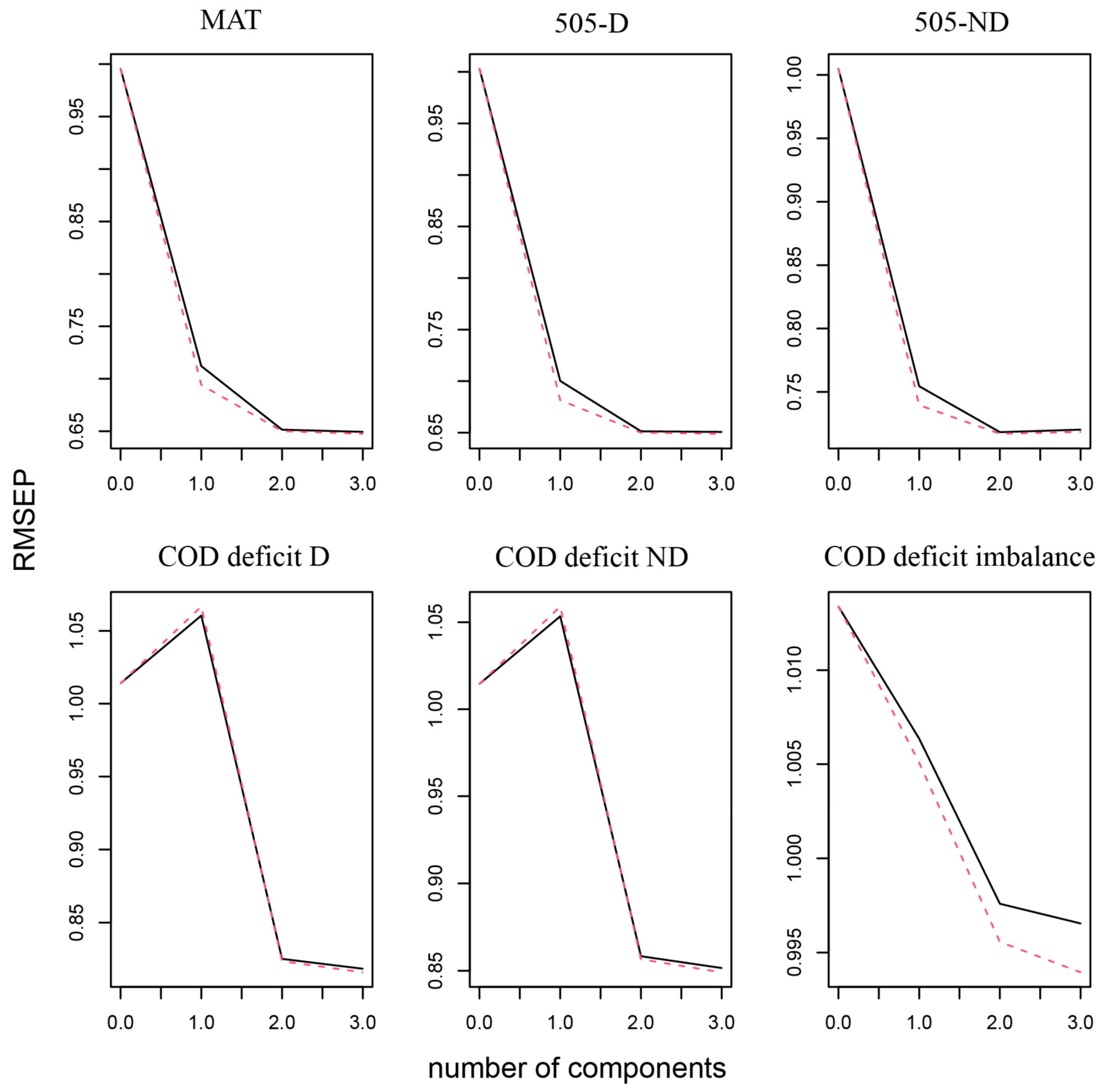
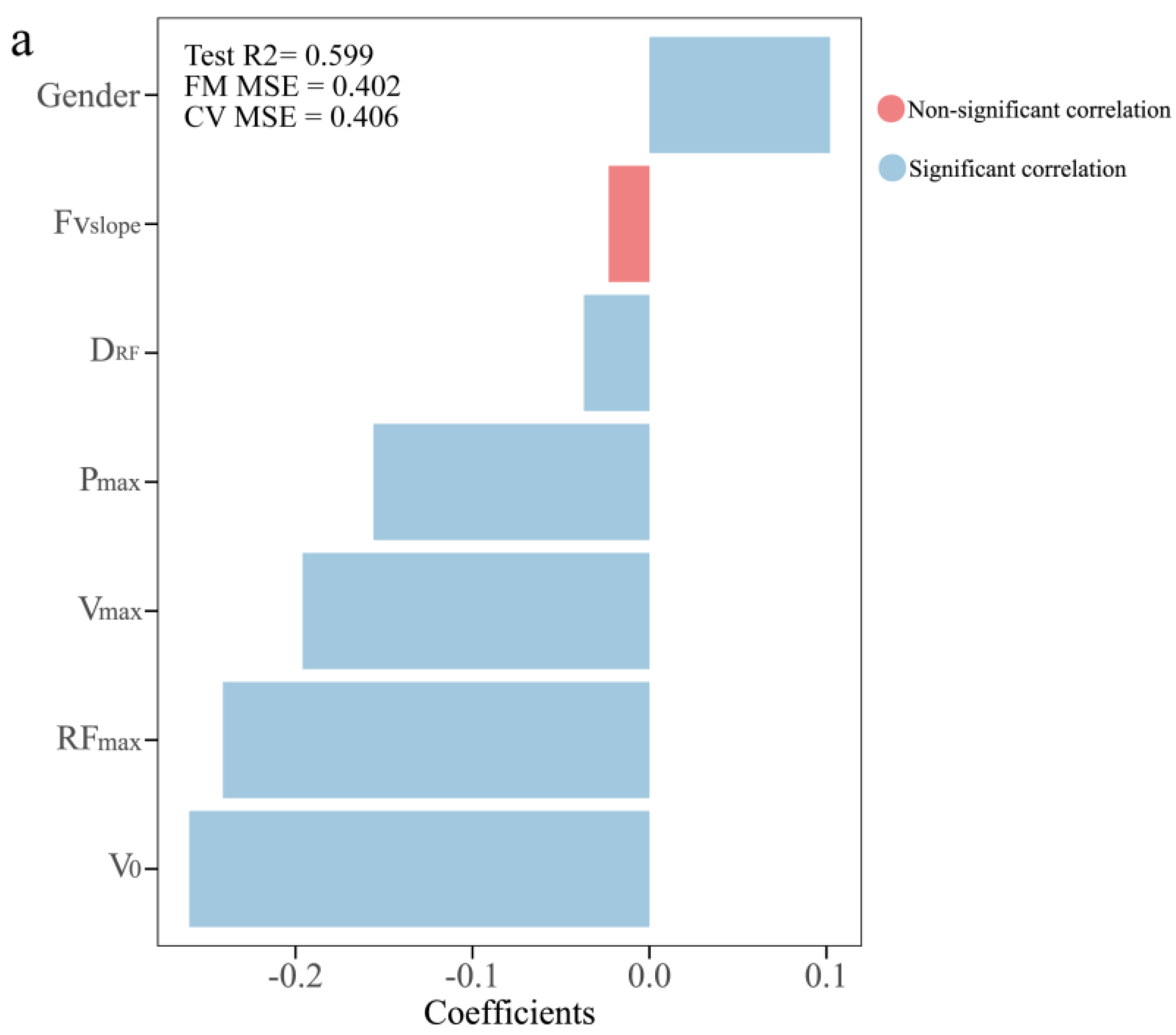
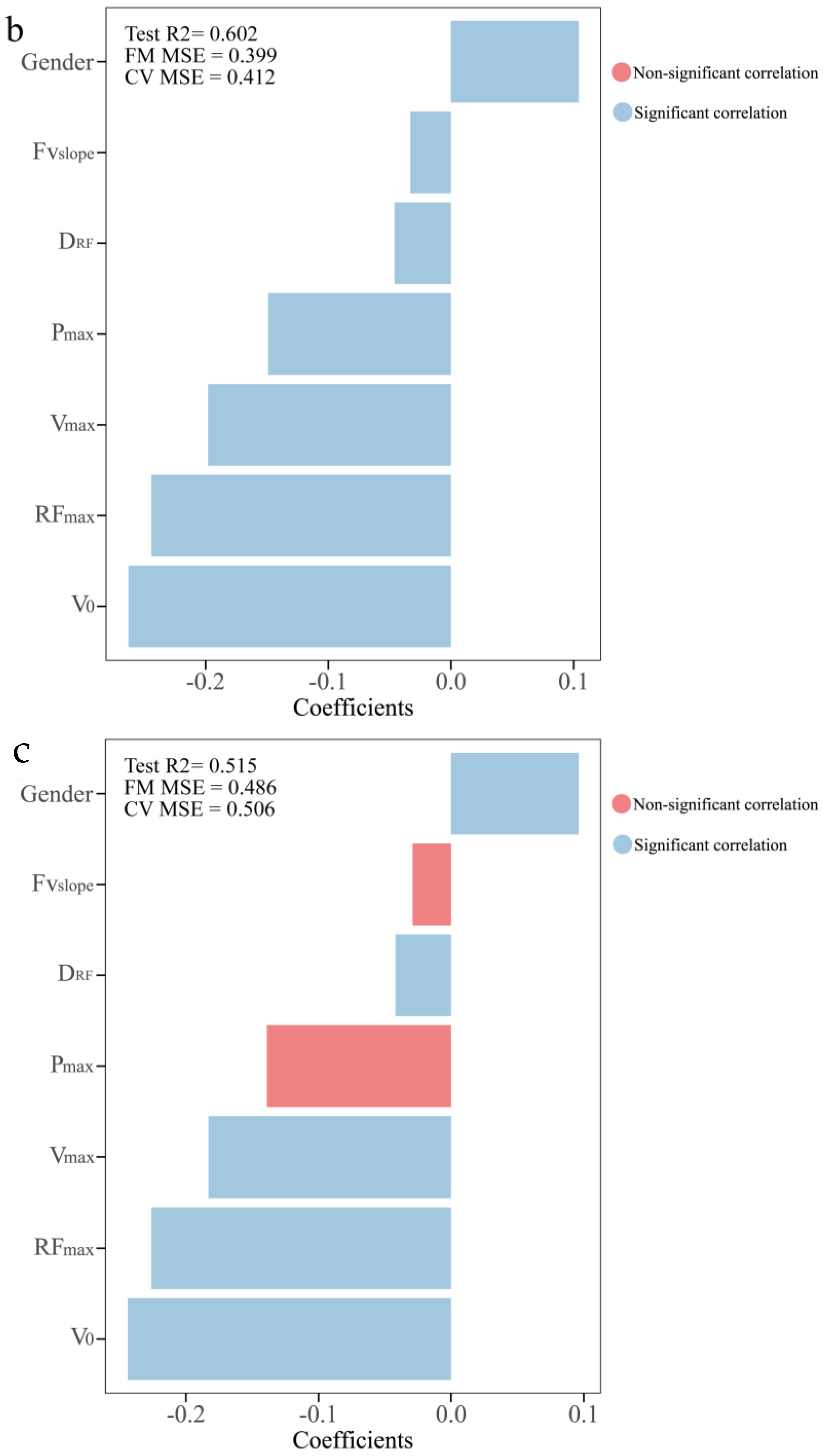
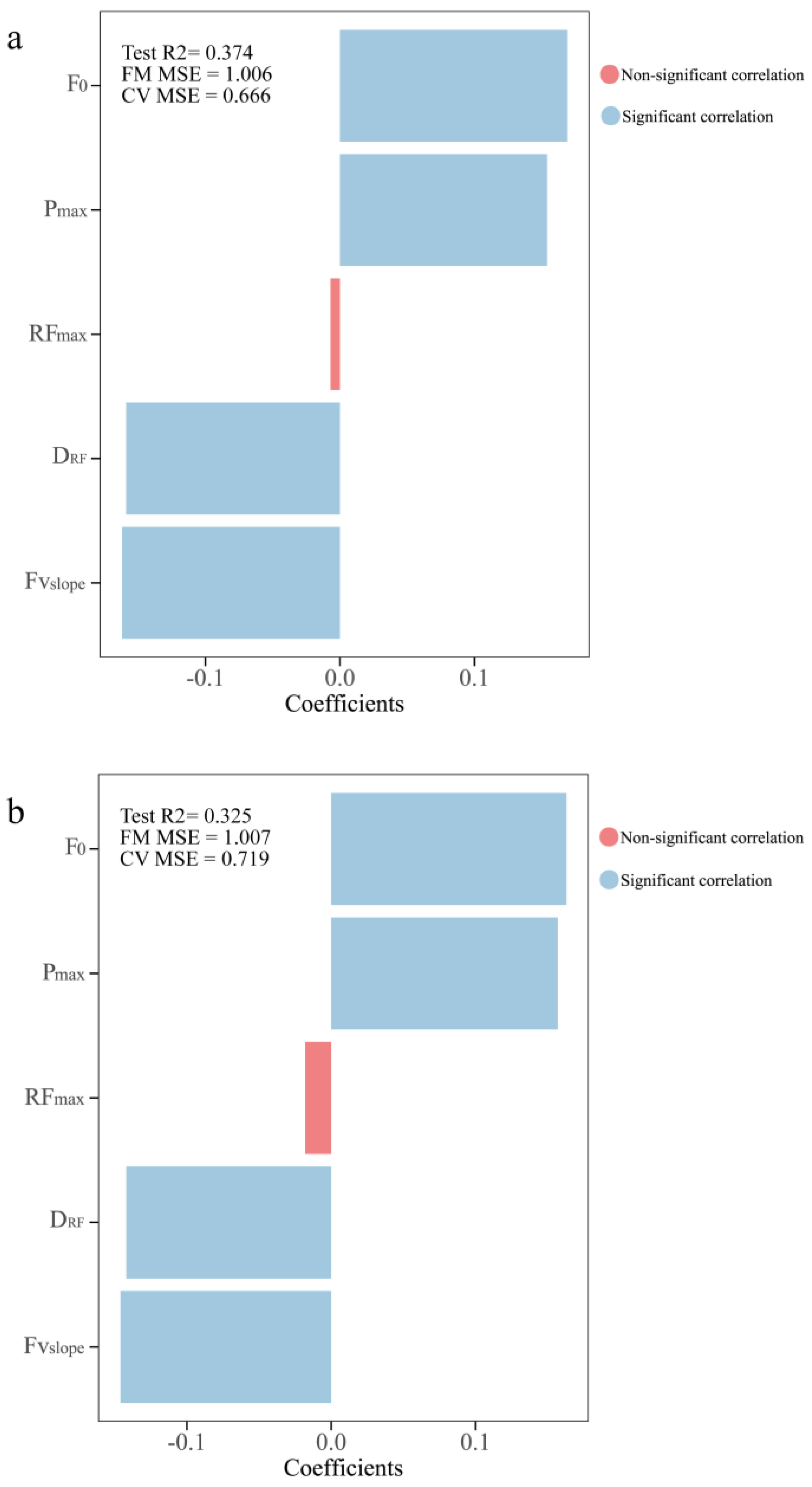
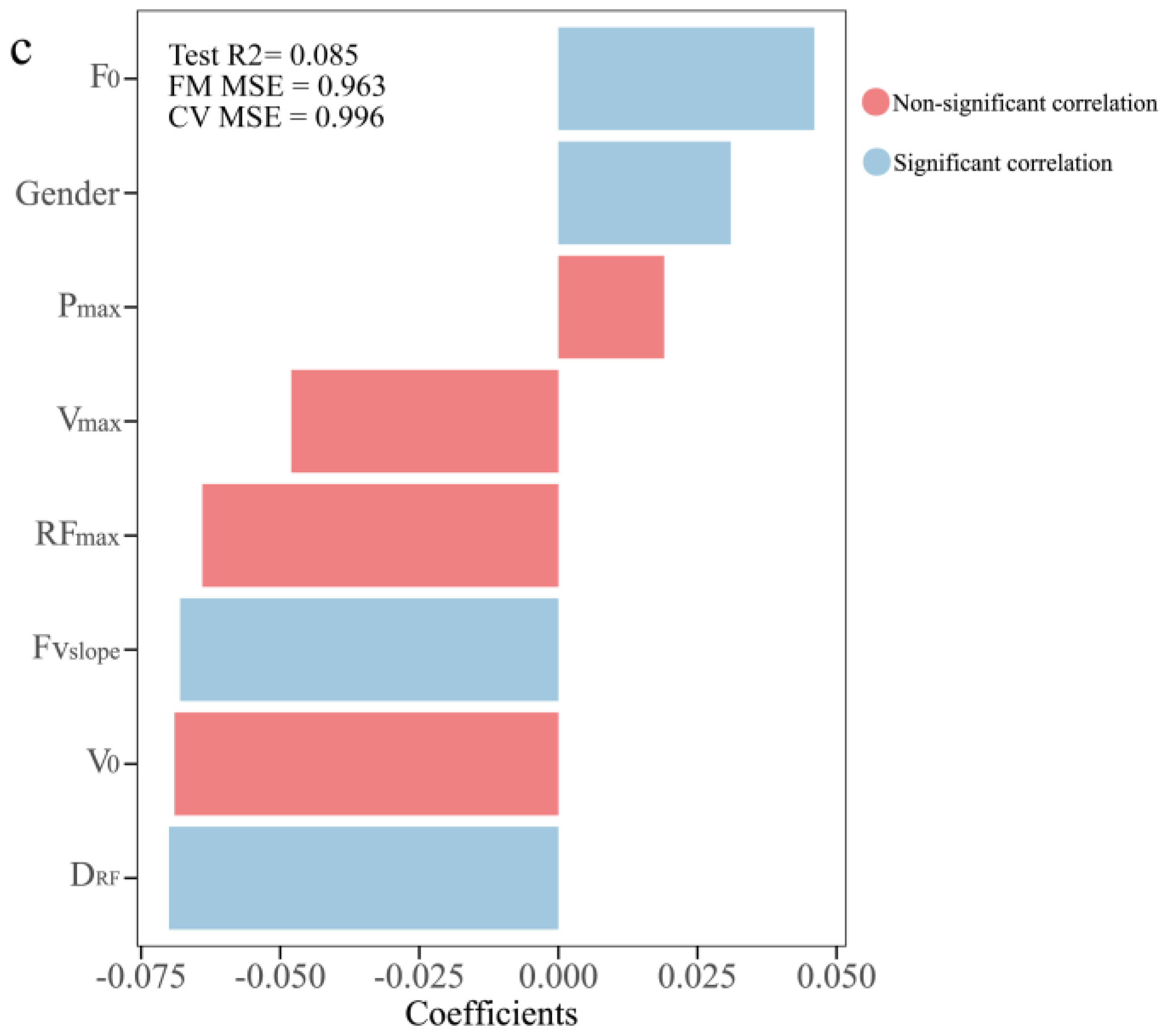
| Variables | Medians (IQR) |
|---|---|
| Sprint Fv profile | |
| F0 (N·kg−1) | 12.96 (8.33, 28.12) |
| V0 (m·s−1) | 7.97 (5.47, 9.33) |
| Pmax (W·kg−1) | 26.43 (12.17, 56.10) |
| RFmax | 0.50 (0.37, 0.55) |
| DRF | −0.15 (−0.35, −0.10) |
| Fvslope (N·s·m−1kg−1) | −1.64 (−3.61, −1.09) |
| Vmax (m/s−1) | 7.84 (5.41, 9.02) |
| COD Performance tests | |
| Time to 10 m (s) | 1.82 (1.50, 2.41) |
| MAT (s) | 5.73 (4.84, 7.67) |
| 505-D (s) | 2.36 (1.99, 2.94) |
| 505-ND (s) | 2.43 (2.11, 3.02) |
| COD deficit D (s) | 0.53 (0.23, 1.07) |
| COD deficit ND (s) | 0.61 (0.24, 1.08) |
| 505 COD imbalance (%) | −2.58 (−7.4, −0.04) |
| COD deficit imbalance (%) | −11.22 (−34.89, −0.12) |
| β (SE) | T | p-Value | adj-R2 | ||
|---|---|---|---|---|---|
| MAT | Intercept | −0.034 (0.06) | −0.535 | 0.594 | 0.59 |
| Comp1 | −0.451 (0.04) | −11.94 | <0.001 * | ||
| Comp2 | −0.028 (0.03) | −0.842 | 0.402 | ||
| 505-D | Intercept | −0.019 (0.06) | −0.294 | 0.770 | 0.59 |
| Comp1 | −0.456 (0.04) | −12.053 | <0.001 * | ||
| Comp2 | −0.010 (0.03) | −0.303 | 0.763 | ||
| 505-ND | Intercept | −0.017 (0.07) | −0.239 | 0.812 | 0.50 |
| Comp1 | −0.423 (0.04) | −10.083 | <0.001 * | ||
| Comp2 | −0.011 (0.04) | −0.305 | 0.761 | ||
| COD deficit D | Intercept | −0.005 (0.08) | −0.057 | 0.954 | 0.36 |
| Comp1 | 0.004 (0.05) | 0.089 | 0.929 | ||
| Comp2 | 0.322 (0.04) | 7.571 | <0.001 * | ||
| COD deficit ND | Intercept | −0.002 (0.08) | −0.025 | 0.980 | 0.31 |
| Comp1 | 0.050 (0.05) | 1.01 | 0.315 | ||
| Comp2 | 0.297 (0.04) | 6.727 | <0.001 * | ||
| 505 COD imbalance | Intercept | −0.008 (0.10) | −0.081 | 0.935 | 0.05 |
| Comp1 | −0.151 (0.06) | −2.582 | 0.011 * | ||
| Comp2 | −0.005 (0.05) | −0.098 | 0.922 | ||
| COD deficit imbalance | Intercept | −0.009 (0.10) | −0.088 | 0.930 | 0.07 |
| Comp1 | −0.122 (0.06) | −2.115 | 0.037 * | ||
| Comp2 | 0.109 (0.05) | 2.103 | 0.038 * |
Disclaimer/Publisher’s Note: The statements, opinions and data contained in all publications are solely those of the individual author(s) and contributor(s) and not of MDPI and/or the editor(s). MDPI and/or the editor(s) disclaim responsibility for any injury to people or property resulting from any ideas, methods, instructions or products referred to in the content. |
© 2024 by the authors. Licensee MDPI, Basel, Switzerland. This article is an open access article distributed under the terms and conditions of the Creative Commons Attribution (CC BY) license (https://creativecommons.org/licenses/by/4.0/).
Share and Cite
Zhang, Z.; Jiang, M.; Jing, Y.; Li, M.; Li, Y.; Yang, X. Associations Between Sprint Mechanical Properties and Change of Direction Ability and Asymmetries in COD Speed Performance in Basketball and Volleyball Players. Life 2024, 14, 1434. https://doi.org/10.3390/life14111434
Zhang Z, Jiang M, Jing Y, Li M, Li Y, Yang X. Associations Between Sprint Mechanical Properties and Change of Direction Ability and Asymmetries in COD Speed Performance in Basketball and Volleyball Players. Life. 2024; 14(11):1434. https://doi.org/10.3390/life14111434
Chicago/Turabian StyleZhang, Zhihao, Mingchen Jiang, Yifan Jing, Mingjia Li, Yanchun Li, and Xiaolin Yang. 2024. "Associations Between Sprint Mechanical Properties and Change of Direction Ability and Asymmetries in COD Speed Performance in Basketball and Volleyball Players" Life 14, no. 11: 1434. https://doi.org/10.3390/life14111434
APA StyleZhang, Z., Jiang, M., Jing, Y., Li, M., Li, Y., & Yang, X. (2024). Associations Between Sprint Mechanical Properties and Change of Direction Ability and Asymmetries in COD Speed Performance in Basketball and Volleyball Players. Life, 14(11), 1434. https://doi.org/10.3390/life14111434






